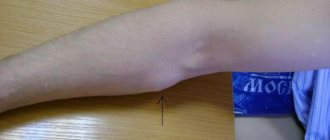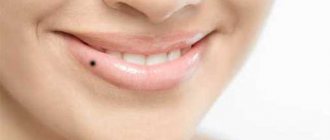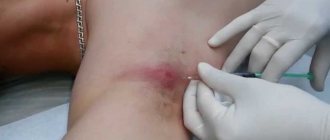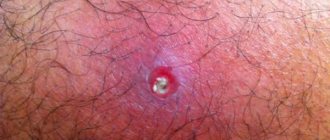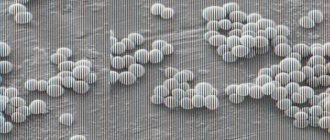The mechanism of boil formation
The causative agent of furunculosis is Staphylococcus aureus (less often white). The disease occurs when the immune system is weakened, mechanical damage to the skin, or friction with clothing.
An abscess occurs on any area of the skin where there is hair. Stages:
- Infiltration. Redness and a cone-shaped compaction form. An infiltrate appears, which increases in size.
- Suppuration (necrosis). The appearance of a purulent-necrotic core.
- Opening of the apex, discharge of pus (smells specific).
- Healing, scarring.
The duration of healing of the abscess should not exceed 10 days.
In case of furunculosis or the appearance of multiple neoplasms, you should visit specialists.
Symptoms:
- redness, burning, swelling of the skin at the site of the hair follicle. Itching when pressed;
- after 3-4 days the abscess breaks out;
- formation of deep ulcers, scarring.
How to recognize a boil
Recognizing a boil by a doctor or a patient is not difficult. The symptoms are as follows:
- the appearance of a compaction in the center of which the hair is located;
- the skin over the node turns red;
- when palpated by a doctor, pain and fever are felt;
- then a pustule with purulent contents appears;
- redness, size and pain of the nodule increases, it rises above the skin and takes the shape of a cone with a necrotic core in the center;
- general weakness appears, possible low-grade fever (up to 38°C);
- movements that stretch the skin in the area of inflammation cause severe pain.
If the course is uncomplicated, the boil will break out in 8-10 days; it is not necessary to see a doctor. A rod will emerge consisting of purulent masses, necrotic tissue and hair.
Differences in the treatment of boils of particular localization
Places of occurrence of neoplasms are the abdomen, buttocks, back, armpits, and groin area. Less commonly, ulcers appear on the arms and legs. Therapy does not depend on the location. Basic methods:
| Treatment method | Description |
| Physiotherapy | Laser treatment, magnetic therapy, dry heat, UV irradiation. The method is effective for fresh tumors. |
| Conservative | Surgical removal using local anesthesia. |
| Medication | Prescription of antiseptic, antibacterial ointments for wound care (levomekol, ichthyol ointment, Vishnevsky ointment). At the stage of wound scarring - creams to accelerate regeneration (contractubex). |
The location of chiria on the face is dangerous due to infections and complications:
- if located in the area of the nasal folds – blindness;
- localization on the face - inflammation of the spinal cord and brain, meningitis.
The groin environment is a favorable area for the development of an abscess; there is high humidity. If a focus of inflammation is detected in places of special localization (head, face, nose, neck, intimate areas: pubic area, anus, genitals), you should immediately consult a doctor. Surgical removal will be scheduled. It is recommended to abstain from sexual intercourse during treatment. The pubic sore itself is not contagious, but the pus that is released after the rupture contains bacteria.
Chiryak under the eye (stye is another disease) is accompanied by an abscess of the hair follicle and sebaceous gland. The disease is treated with antibacterial drops: chloramphenicol, floxal, tsipromed, tetracycline eye ointment.
Dermatologist
Any diseases involving the skin require consultation with a dermatologist. It wouldn’t hurt to see this doctor in the early stages of boil development. It will complement your physician's prescriptions and provide more specialized recommendations regarding topical treatments and skin care. However, during the suppuration phase, with unusual or dangerous localization of the boils, the help of other doctors is necessary.
Which doctor should I contact?
First you need to contact a therapist, who will examine you and refer you to a specialist. The doctor treating the boil will take an anamnesis and issue a referral for general and biochemical blood tests, a smear, and an ultrasound examination.
The question “which doctor will cure a boil” will be answered by a general practitioner after an examination.
Dermatologist
If a boil appears on the face, which doctor should I contact? For single lesions, you need to visit a dermatologist. The doctor will collect anamnesis and refer you for tests. Fresh formations are treated with physiotherapy. At the same time, the patient will be advised to apply bandages with antiseptic ointments to the affected area.
Surgeon
If you have a boil, you need to see a surgeon. The specialist is removing the tumor, but in order to avoid relapses in the future, you need to find out the reason for the formation of the boil.
Under local anesthesia, the doctor opens the purulent lesion with a scalpel. After removing the boil, drain the wound and apply an antiseptic bandage.
Further treatment: antimicrobial, wound healing, antiseptic ointments. Bandages are changed daily.
Other specialists
- An immunologist determines the causes of decreased immunity. Boils emerge if the body is weakened, so treatment with immunomodulators and biostimulants is necessary;
- infectious disease specialist - in case of secondary infection;
- endocrinologist - will cure purulent foci that have arisen due to hormonal imbalance;
- ENT specialist – for formations in the nose and ear of an adult and a child;
- gynecologist – in women it is located on the genitals;
- A hematologist will help you get rid of boils that have arisen due to blood diseases.
Specialization of a doctor who treats furunculosis
If an incomprehensible redness appears on the skin and you can’t get rid of it on your own, you don’t need to solve the problem yourself, since you have to deal with a boil. Only a doctor can treat it.
A painful lump may form over several days. Pimples take the form of red spots, when touched, a person feels incredible pain.
To avoid mistakes in treatment, expert advice will be useful.
The course of treatment is not so complicated, the patient can perform all the actions independently, but in order not to waste time simply, the doctor can competently distribute the patient’s efforts so that all his actions are beneficial.
But before you start working with such an illness, you need to fundamentally understand what it is and how to deal with it, and most importantly, which doctor to see.
What is furunculosis, furuncle and carbuncle
All these three words are stages of the disease at which you need to follow the prescribed course of treatment. Each of them has its own symptoms, so it is not difficult to distinguish them. To understand which doctor to contact, you must first understand the symptoms of the disease.
A furuncle is a purulent inflammation of the scalp. Once pathogenic microflora gets under the skin, a boil may appear.
If the boil is presented in a single quantity, this is not scary, since this is a completely common phenomenon, characteristic of everyone and does not pose any danger.
But when it comes to the ears, eyes, nose and neck, when strange discharge appears there, then this should be treated with special attention, since these places are connected to the brain. And since we have to deal with an infection, under no circumstances should we allow it to enter the brain.
A carbuncle consists of several boils that are combined with each other. If there are carbuncles on the body, then the patient has serious health problems. Such treatment requires contacting a surgeon, since in most cases the issue can be resolved through surgery.
If chiria appears regularly and it is not possible to fight them, then the body is affected by furunculosis, which can spread throughout the body in a short time. In this case, you need to consult a doctor as soon as possible, otherwise the problem may last and worsen for years.
Which doctor should I go to?
If the patient is absolutely sure that he is affected by boils, he should contact one of the doctors:
- therapist;
- dermatologist;
- surgeon.
It all depends on the severity of the disease. If a person is struck by such a serious illness in the early stages, then visiting one therapist will be enough. If he realizes that the problem can go much further, he may further refer him to a dermatologist or surgeon.
If the patient initially does not know which doctor treats boils, it is better to recommend that he contact a general practitioner. The doctor will analyze the stage of the disease and, if necessary, prescribe a course of treatment or refer you to a competent specialist.
It is important not to try to use any ointments on your own, only as prescribed by your doctor. With the help of drug intervention, you can provoke a worsening of the condition.
Contacting a dermatologist when treating an illness
A dermatologist is also competent in this matter. But it can only stop the spread of the disease. You can contact it only in the early stages, when the boil appears in a single copy on the skin.
As a rule, he prescribes a course of various ointments and a strict time and period of application. Most often, the course completely removes the disease from the patient’s skin.
Many people advise using folk remedies when the boil is fully mature, but dermatologists say the opposite, since the boil at the first stage is not dangerous and it will be much easier to stop its development.
Contacting a surgeon
Which doctor treats boils in the second and third stages, the patients themselves told. Of course, only a surgeon can help in such a serious matter.
The surgeon may prescribe the following treatment techniques:
- broad-spectrum antibiotics are used;
- assignment of corrective actions;
- autohemotherapy is prescribed;
- aloe extract injections;
- gamma globulin is used;
- immunotherapy with staphylococcal vaccine is carried out;
- take fresh brewer's yeast and sulfur powders.
Antibiotics have a wide spectrum of action and since they are used for inflammation, purulent problems are also subject to them. But in this case, strong antibiotics will be required, which are issued only with a surgeon's prescription.
Corrective actions and autohemotherapy are used if carbuncles can still be eliminated without the use of antibiotics. But this happens extremely rarely, since patients usually seek help when the disease has spread significantly over the skin.
Traditional medicine and immunotherapy
Although many doctors do not accept traditional therapy, aloe extract is ideal for fighting boils. It has a strong effect on the cause of boils, thereby stopping their reproduction.
At the second stage, aloe will help to gradually get rid of the problem. It will not be possible to complete treatment with this natural drug, since it does not cure, but stops the appearance of new acne.
Gamma globulin, like aloe, increases resistance to the disease.
If the case is too severe, immunotherapy with a staphylococcal vaccine is performed. This procedure can significantly strengthen the resistance of the immune system, but it is prohibited to abuse the vaccine, since it directly affects the nervous system, which can cause a number of other troubles. The surgeon decides to give the patient the vaccine only in the most acute manifestations.
Brewer's yeast is a famous solution to the problem, which is still used by private practitioners. The method really works and has no side effects.
But brewer's yeast cannot completely remove a person from the disease and they are not included in the course of therapy.
With their help, you can only slightly strengthen the immune system and increase the body's resistance to illness, but they cannot be cured.
Who to contact if there is no surgeon nearby
As an option, they usually resort to the help of private practitioners who have a narrow specialization and help only in certain issues.
Such specialists can carry out express treatment, which is very unsafe for health and can cause unbearable pain.
For example, therapy using pure ichthyol until the boil is opened, then to suck out the pus, apply it on top and apply several layers of gauze, previously moistened with a hypertonic solution.
If the situation is with a carbuncle, then sucking out such pus will not be difficult, but if you have to deal with furunculosis, then you can only imagine how much pain the patient will endure when removing each pimple. Therefore, such a specialist should be contacted only in case of urgent need or a hopeless situation.
Depending on the number of chiries, as has already become known, it is clear which doctor to contact.
But before making any decisions, it is better to first consult with a therapist; he will tell you which doctor can provide qualified assistance in his problem.
At the first sign of danger, you should not hesitate, since the sooner the patient begins the course of treatment, the easier the body will tolerate the therapy.
Source: //dermatolog03.ru/chirey/vrach-kotoryj-lechit-furunkulez.html
What symptoms should you be wary of?
- The formation of multiple foci indicates furunculosis.
- You should consult a doctor if you find an abscess near moles or age spots.
- Constant appearance on the face and genitals requires a visit to the doctor.
- The boil appeared on the face (lips, cheeks, nose, head).
- An abscess in a baby.
- Increased body temperature above 38°C.
- Fever, chills, deterioration of general condition.
- Transition of the abscess to the abscess stage (on the 3rd-4th day a purulent-necrotic core does not form, the formation continues to abscess).
- The appearance of a tumor on the body with concomitant diseases: diabetes mellitus, endocrine diseases, metabolic disorders.
- No improvement on days 5-7.
- The swelling spreads to nearby tissues.
At home, fresh ulcers that are small in size are treated.
During the treatment period, do not touch the tumors with dirty hands, and do not open the abscess yourself. Wear clothes made from natural fabrics and avoid friction. It is better to wash your hands with antibacterial soap during therapy. The article has been verified by the editors
Surgeon
When considering a situation with a mature or large abscess, in answering the question of which doctor treats boils, one cannot do without a surgeon. By contacting him, you can expect safe opening, washing and drainage of the abscess. After this, a bandage with antibacterial ointment is applied, which is changed daily.
It should be understood that it is impossible to effectively cure a boil without extracting the pus, and delaying such an operation can lead to dangerous complications. In severe situations, hospitalization with intensive care and constant supervision by the attending physician may be necessary.
Attending doctor
If you notice that a boil has appeared on your body, go to the surgeon. and the sooner the better. He will determine how severe the disease is and prescribe a treatment regimen; will explain whether therapy can be carried out at home or whether there is a need to go to the purulent ward.
You should consult a doctor immediately if a boil appears in the temple area, upper (lower) lip, near the eye, on the forehead or neck, since inflammation of the cerebral cortex can be complications!
Furuncle: causes of formation. stages of development, treatment. When should you see a doctor with a boil?
NEAD EAD SEAD South Administrative District South-Western Administrative District CJSC Central Administrative District SZAO Northern Administrative District 01 02 03 05 06 07 08 09 1 0 1 1 1 2 14 18 15 16 17 Babushkinskaya Prospekt Mira Pervomaiskaya Baumanskaya Paveletskaya Teply Stan Shipilovskaya Prague Academic University Barrikadnaya River Station Oktyabrskoye Bratislava Taganskaya Academician Yangelya October Field
Ekaterina Alekseevna Trischilova Head of Clinical Diagnostic Department
A furuncle is a purulent inflammation of the hair follicle (follicle) involving the sebaceous gland and surrounding tissues in the inflammatory process. If inflammation affects several follicles at once, a carbuncle
– extensive and rapidly developing inflammation, a disease more dangerous than a boil.
If several boils occur simultaneously (in different parts of the body), they speak of furunculosis
.
The popular name for a boil is also widely known - boil .
Causes of boils
The cause of the boil is a bacterial infection. Most often - Staphylococcus aureus. Bacteria enter the hair follicle, causing inflammation. The penetration of infection is facilitated by the presence of skin lesions, including:
- scuffs, scratches, abrasions. In men, the formation of boils on the face may be preceded by cuts when shaving;
- scratching for dermatological diseases;
- violation of the protective properties of the skin during prolonged contact with liquid. Therefore, increased sweating is a factor that increases the risk of developing a boil. Also, boils can occur inside the ear canal or in the nose, and the provoking factor is prolonged exposure to the skin of mucous or purulent secretions due to diseases, respectively, otitis (inflammation of the ear) or rhinitis (inflammation of the nasal mucosa);
- constant contamination of the skin, including those associated with professional activities (when the skin comes into contact with lubricating oils, cement, coal or lime dust, etc.).
Under normal conditions, the body's defense system prevents the development of inflammation. However, if the immune system is weakened, the risk of developing boils increases. In the case of multiple boils (furunculosis), the factor of decreased immunity is almost always present. The formation of boils is promoted by:
- chronic infectious diseases (tuberculosis, hepatitis, sinusitis, tonsillitis, bronchitis, pyelonephritis);
- HIV;
- hypothermia or, conversely, overheating. Hypothermia often becomes a factor provoking the formation of boils in adolescents;
- improper nutrition (depletion of the body, hypovitaminosis);
- diseases manifested in the form of metabolic pathologies (diabetes mellitus, endocrine disorders);
- treatment with drugs that suppress the immune system (used in the treatment of cancer and in some other cases);
- chronic fatigue;
- stress.
Symptoms of a boil
A boil can form anywhere there are hair follicles (that is, almost anywhere except the palms and soles). Most often, a boil occurs where the skin sweats, rubs and gets dirty the most - on the neck, forearms, in the armpit or groin area, on the lower back, hips and buttocks. Often boils appear on the face.
In its development, the boil goes through several stages:
At the first stage, an infiltrate appears around the mouth of the hair follicle - a swollen area with pronounced redness and thickening of the skin. The infiltrate gradually increases and can reach a diameter of 1 to 3 cm. The skin around the infiltrate becomes tense and also becomes painful, and sometimes a tingling sensation is felt. In this case, people say “a boil is brewing.”
Purulent-necrotic stage
The next stage is called purulent-necrotic.
On average, 3-4 days after the first signs of boil formation appear, a characteristic rod appears, consisting of pus and dead tissue, the end of which rises above the surface of the skin in the form of an abscess-pustule. If the boil is located on the face, in the ear, or on the neck, during this period there may be an increase in temperature to 38 ° C, general weakness, loss of appetite, and headache.
Boil breakthrough and healing
At some point, the pustule breaks through and the necrotic core comes out. Unpleasant symptoms disappear and healing begins. Within 3-4 days, the wound at the site of the boil heals. A scar is formed, which over time can become almost invisible.
Treatment methods for boils
Under no circumstances should you try to squeeze out the boil yourself, massage it or put pressure on the area around the boil. The infection can enter the bloodstream and cause blood poisoning (sepsis). It is worth remembering that there are active pathogenic bacteria inside the abscess. Therefore, you should not touch the boil, and if you do touch it, you must immediately wash your hands with soap.
For a single small boil, treatment at home is possible. You should definitely consult a doctor if:
- within 3 days the boil does not develop a head and the pain only increases;
- the boil is too large or painful;
- the boil is located on the neck, ear, nose, face, spine or anus. These areas are the most dangerous from the point of view of the development of complications;
- the temperature has increased;
- red stripes appeared radiating from the boil (this is a symptom of inflammation of the lymphatic vessels - lymphangitis);
- with multiple boils (furunculosis). In case of furunculosis, you should definitely consult a doctor, even with small boils;
- the boil occurred against the background of diabetes mellitus.
A surgeon treats boils. If large boils occur, surgical opening, sanitation and drainage of the wound are performed. Treatment of furunculosis is usually complex, including the use of both local remedies and general therapy, which is necessary, first of all, to increase the body's immunity.
All diseases
fdoctor.ru uses cookies. Terms of use.
Source: https://www.fdoctor.ru/bolezn/furunkul/
How to distinguish pathology?
There are many diseases similar to boils or furunculosis. Patients often confuse them with each other, so they are not successful in trying to cure themselves. When a doctor treats boils, he is absolutely sure of the diagnosis.
Pathology should be distinguished from:
- Anthrax. At first, the pathology takes the form of a nodule or vesicle, which eventually becomes covered with a black scab. The skin is very swollen and painful. The general condition is significantly impaired.
- Hidradenitis. The inflammatory process is localized in the sweat glands. There is no necrotic core in the affected area and there is no staged process.
- Deep trichophytosis. The most common locations are scalp and beard hair. In this case, the skin elements do not have a core and do not hurt. To confirm the diagnosis, the doctor prescribes microscopy, which identifies fungal pathogens in the material taken.
If a specialist treats furunculosis, he pays attention to the general condition of the patient and associated pathologies. For example, if a patient has diabetes, there is no doubt about the diagnosis. If the doctor finds it difficult to make a diagnosis, a histopathological examination should be done.
Treatment options
The surgeon treats boils in three ways:
- Opens the abscess and clears the pus.
- Prescribes antibiotic therapy.
- Gives recommendations for care and waits for the boil to mature.
The boil cannot be squeezed out on your own! This may allow the infection to spread internally. You can apply a sterile bandage with Vishnevsky ointment or just a warm compress. A week after formation, independent maturation and self-purification occur.
CARBUNCLE
In some cases, purulent inflammation of several neighboring hair follicles occurs at once; such an extensive inflammatory focus is called a carbuncle.
Fertile “soil” for the active reproduction of microbes and the development of disease is skin contamination, violation of hygiene rules and microtrauma (for example, during shaving), weakening of the body’s defenses in chronic diseases, stress, hypothermia, hypovitaminosis, diabetes.
As with any infectious inflammatory disease, the course of a boil may be accompanied by fever, chills, and headache. At the very beginning of the disease, a dense, itchy and painful red nodule appears at the base of the hair, rising above the skin. After a few days, a softening appears in the center of the nodule, which contains pus. An improvement in the general condition and normalization of body temperature are observed after opening the abscess, in the place of which a greenish-black area appears - a rod, which after a few days is rejected on its own. The full “cycle” of the disease rarely lasts more than a week and ends with the formation of a barely noticeable scar.
If boils constantly recur, it is necessary to conduct an additional examination - take a biochemical blood test with mandatory determination of glucose and lipid levels.


